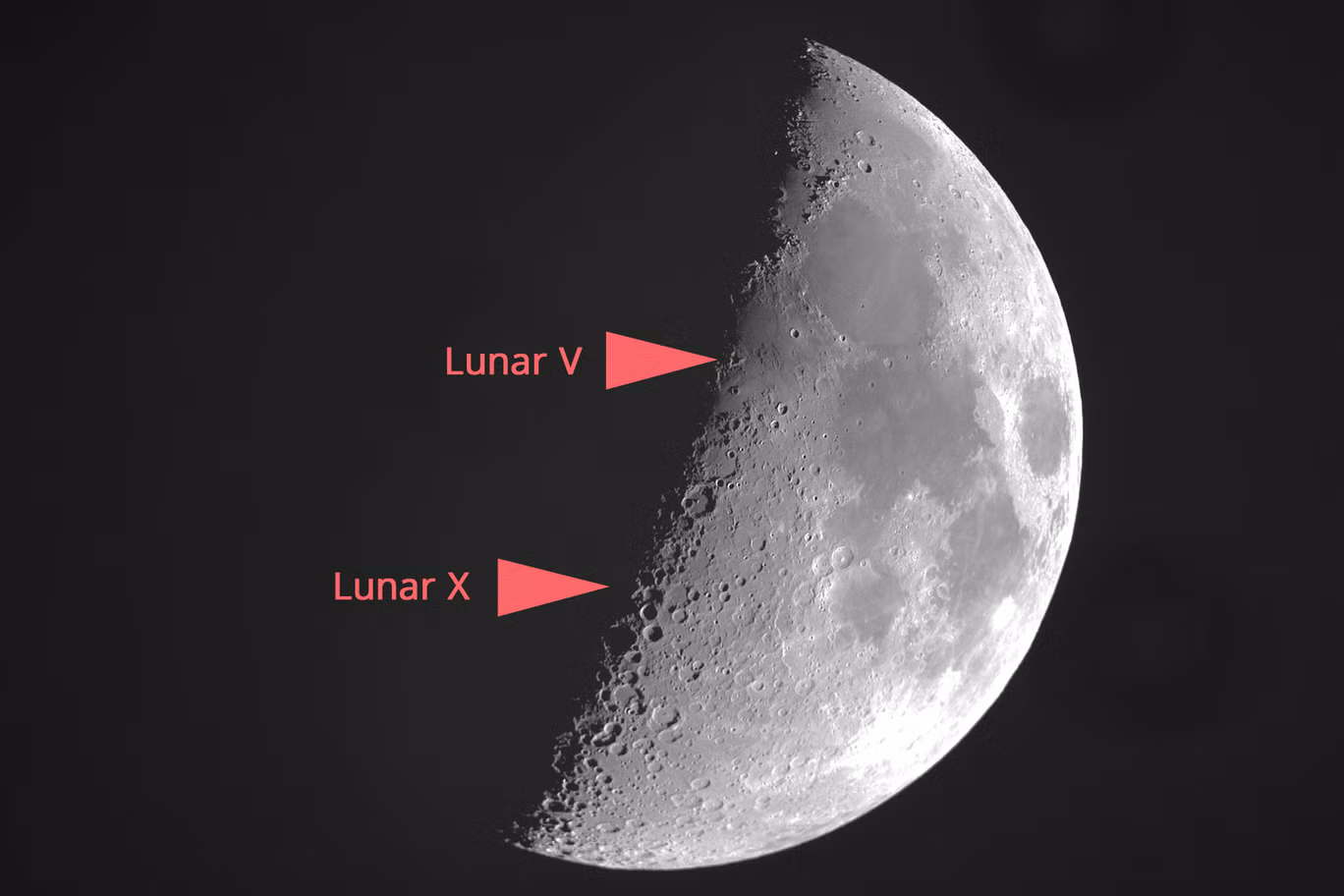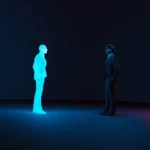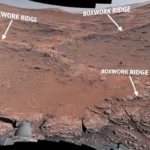Tonight, skygazers are in for a truly captivating celestial treat. The Moon will present a rare and fascinating optical illusion: the appearance of a “giant glowing X and V” on its surface.
This unusual phenomenon is not a permanent feature of our lunar neighbor. Instead, it forms under very specific conditions. It occurs precisely “when the sunlight hits the lunar surface at just the right angle.” This creates striking patterns of light and shadow that resemble familiar alphabetical characters.
This rare celestial event is expected to be visible for approximately “four hours.” It coincides with a crucial phase in the Moon’s cycle: as it approaches its first quarter moon phase. During this period, the angle of illumination from the Sun becomes optimal for these unique formations. Both the “X” and the “V” are not etched into the Moon’s surface as permanent symbols. Rather, they are ephemeral creations of light and shadow. They form from sunlight grazing the rims and interiors of specific craters on the Moon.
This creates an effect that can be observed from Earth. For amateur astronomers and curious observers alike, this presents a remarkable opportunity. It is a chance to witness the dynamic interplay between sunlight, lunar topography, and orbital mechanics. This fleeting spectacle underscores the beauty and complexity of our solar system, reminding us of the subtle wonders constantly unfolding above us.
The Anatomy of the Lunar X and Lunar V
The appearances of the Lunar X and Lunar V are not random. They are the result of specific craters being illuminated in a precise way. These formations become visible as sunlight catches their contours, casting elongated shadows that connect to form the familiar shapes.
The Lunar V formation takes shape when light specifically “illuminates the Ukert crater.” This crater, under the correct lighting conditions, creates the distinct “V” outline. The Lunar X, arguably the more famous of the two, is formed from the combined illumination and shadow play of three different craters: the Bianchini crater, the La Caille crater, and the Purbach crater. The intricate interplay of light and shadow across the rims and interior walls of these three craters gives rise to the sharp, cross-like appearance of the “X.”
For optimal viewing, both the Lunar X and Lunar V will only be observable through “a telescope or binoculars.” They are not visible to the naked eye. Crucially, observers must point their optical instruments specifically at the Moon’s “terminator.” The terminator is the dynamic line that “separates its light and dark side.” This line is not static; it constantly shifts as the Moon progresses through its phases.
However, it is precisely along this boundary where sunlight strikes at an oblique angle, creating the elongated shadows necessary for these phenomena to appear. Without a telescope or a good pair of binoculars, these intricate details and illusions will simply remain unseen, blending into the Moon’s broader illuminated surface. Therefore, having the right equipment is essential for anyone hoping to catch this rare celestial display.
The Significance of the Terminator for Observation
The Moon’s terminator is a focal point of immense interest for amateur astronomers, and for good reason. It is often described as the “most interesting part of the Moon for amateur astronomers to observe.” The unique lighting conditions along this dividing line between lunar day and night significantly enhance the visual experience.
As NASA’s website eloquently explains, “The lunar surface appears different nearer the terminator because there the Sun is nearer the horizon and therefore causes shadows to become increasingly long.” This oblique angle of illumination is key. These extended shadows are not merely aesthetic. They serve a crucial function for observation. They “make it easier for us to discern structure, giving us depth cues so that the two-dimensional image, when dominated by shadows, appears almost three-dimensional.” This dramatic play of light and shadow provides a sense of topography and relief that is often lost when the Sun is directly overhead on other parts of the Moon.
Furthermore, NASA notes that “as the Moon fades from light to dark, shadows not only tell us the high from the low, but become noticeable for increasingly shorter structures.” This means that even subtle variations in lunar topography, such as the rims of smaller craters or low-lying ridges, become more prominent and easier to distinguish when illuminated by the low-angle sunlight at the terminator. For instance, “many craters appear near the terminator because their height makes them easier to discern there.”
The shadows cast by crater rims are particularly striking, revealing the depth and morphology of these impact features in stark detail. This makes the terminator an unparalleled region for studying the Moon’s surface in rich, three-dimensional fidelity, which is precisely why the Lunar X and V phenomena are best observed along this dynamic boundary.
Prime Time for Viewing: When and Where to Look
For eager skywatchers, knowing the precise timing and general sky conditions is paramount to catching this fleeting lunar spectacle. The Lunar X and Lunar V phenomenon is scheduled to appear from 4:41 AM UTC on July 3rd. This corresponds to 11:41 PM EDT on July 2nd for those in Eastern Daylight Time. Given the timing, observers in the Americas will have the earliest opportunities to view the phenomena during their evening hours on July 2nd. For those in Europe and other Eastern longitudes, the event will unfold in the early morning hours of July 3rd.
In terms of local visibility, the skies over the British Isles are generally “expected to be mostly clear at this time,” according to the latest weather forecast from the Met Office. This bodes well for observers in England, Scotland, and much of Ireland, offering favorable conditions for stargazing. However, potential viewers should be aware that “parts of Wales and the west coast of Ireland will be obscured by cloud.” Local weather conditions can always vary, so it’s advisable for aspiring observers to check their specific local forecast closer to the viewing time. Clear skies are, of course, a prerequisite for any astronomical observation.
It’s also important to manage expectations regarding the speed of the phenomenon. As astronomer David Chapman noted in a paper on the subject, “The Werner X [a similar, more localized phenomenon sometimes also called Lunar X] does not leap out all at once but gradually appears over an interval of two hours and 20 minutes as the Sun rises on the spot.” This gradual emergence means that patience is key. Observing the full development of the X and V can be either “excruciatingly slow (if you are in a hurry) or exceedingly quick (if you are attempting to sketch the scene).”
This observation pace is directly linked to the Moon’s slow rotation. Chapman humorously reminds us: “Remember, the Sun rises about 30 times slower on the Moon” than it does on Earth. This slow solar progression ensures that the shadows shift at a leisurely pace, allowing observers to truly appreciate the subtle evolution of these rare lunar illusions. Therefore, setting aside ample time and having a comfortable observing setup will greatly enhance the experience.
The Science Behind Lunar Illusions: Sunlight and Topography
The appearance of the Lunar X and V is a perfect illustration of how the interplay between light, shadow, and topography creates stunning visual effects in space. It is not an atmospheric phenomenon or a trick of the Earth’s atmosphere. Rather, it is a purely lunar-based optical illusion.
The fundamental principle at play is the angle of incidence of sunlight. When sunlight strikes the lunar surface at a high angle (as it does at lunar noon), craters and other features cast very short or no shadows. This makes the surface appear relatively flat and featureless, much like how objects on Earth look under the harsh midday sun. However, as the Sun approaches the lunar horizon – which is precisely what happens at the terminator – the angle of the sunlight becomes very low and oblique.
At this low angle, even slight elevations and depressions on the lunar surface begin to cast long, dramatic shadows. It is these elongated shadows that create the illusion of depth and highlight the Moon’s three-dimensional topography. For the Lunar X and V, specific geological features are perfectly aligned to catch this oblique sunlight. The rims of the craters involved (Ukert for the V; Bianchini, La Caille, and Purbach for the X) are illuminated, while the interior walls or adjacent low-lying areas remain in deep shadow. This contrast between brightly lit ridges and dark, expansive shadows forms the distinct shapes.
Consider the example of the Lunar X. The rims of the three craters (Bianchini, La Caille, Purbach) form intersecting lines that, when illuminated from this precise angle, create the appearance of a cross. If the Sun were higher or lower, the shadows would be either too short or too long, distorting or completely obscuring the “X” shape. This phenomenon is transient because the Moon is constantly rotating, causing the terminator line to continuously move across its surface.
As the terminator advances, the angle of the sunlight changes, and the precise conditions necessary for the “X” and “V” to appear are quickly lost. This fleeting nature adds to the allure and rarity of witnessing these lunar illusions. Observing them is a direct lesson in lunar geomorphology and orbital mechanics, seen through the lens of dramatic light and shadow.
Beyond the X and V: Other Lunar Features at the Terminator
While the Lunar X and V are particularly striking examples, the terminator is a treasure trove for observing many other lunar features. Its unique lighting conditions are ideal for bringing out details that are otherwise difficult to see.
Craters are perhaps the most prominent features highlighted at the terminator. Their bowl-like depressions, created by countless impacts over billions of years, are dramatically revealed by the long shadows cast by their rims. The shadows reveal the depth, shape, and central peaks (if present) of craters with astonishing clarity. Small craters that might be nearly invisible under full illumination become starkly evident at the terminator.
Mountain ranges and isolated peaks also stand out spectacularly. When the Sun is low, mountains cast long, sharp shadows across the lunar plains, allowing observers to gauge their height and extent. Isolated peaks can appear as bright points of light surrounded by darkness, particularly just after local sunrise or just before local sunset on the Moon.
Rimae (rilles) and Rupes (scarps), which are linear features like valleys or cliffs, become much more discernible at the terminator. The low angle of light accentuates their subtle relief, making them easier to trace across the lunar surface. Even the subtle undulations of the mare (dark, basaltic plains) are given a three-dimensional quality by the elongated shadows of small bumps and ridges.
Observing the terminator allows amateur astronomers to engage in a form of lunar geology from Earth. By carefully studying the shadows, one can infer the relative heights and depths of various features, reconstruct impact events, and appreciate the Moon’s rugged, ancient landscape. Many seasoned lunar observers find that the Moon appears most beautiful and informative during its crescent and gibbous phases when a significant portion of the terminator is visible. The Lunar X and V are simply two of the most famous examples of the captivating visual phenomena that unfold along this dynamic boundary of light and shadow, offering a window into the Moon’s complex and ever-changing topography.
Don’t Miss This Fleeting Lunar Gem
Tonight offers a truly rare and visually compelling opportunity for anyone with a pair of binoculars or a small telescope. The simultaneous appearance of the Lunar X and Lunar V is a testament to the elegant interplay of sunlight and lunar topography. These glowing letters, formed by the precise illumination of craters like Ukert, Bianchini, La Caille, and Purbach, are a fleeting reminder of the dynamic beauty of our celestial neighbor.
The event is best observed by focusing on the Moon’s terminator, the crucial line separating light from shadow where oblique sunlight dramatically highlights lunar features. This region is a favorite among astronomers for its ability to reveal the Moon’s three-dimensional landscape through elongated shadows. Set your alarms for 4:41 AM UTC on July 3rd (11:41 PM EDT on July 2nd), and check your local weather forecast for clear skies.
Remember, patience is key, as these phenomena unfold gradually, reflecting the Moon’s slow rotation. Don’t miss this unique opportunity to witness a natural optical illusion that transforms our familiar Moon into a temporary canvas of light and shadow. It’s a perfect moment to connect with the wonders of our solar system and appreciate the subtle artistry of celestial mechanics.








